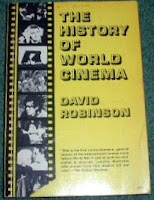 The History of World Cinema
The History of World Cinemaby David Robinson
David Robinson, a British film critic who first started writing for the much respected Sight and Sound, the journal of the British Film Institute, in the 1950s and later in 1973 went on be the film critic for The Times (London), a post that he held right until 1990. The book, first published in 1973 and updated in subsequent editions, unlike most film histories that tend to be US centric, covers European Cinema, especially Polish and Central European filmmakers. Among the Indian filmmakers, the book covers work of Mrinal Sen and not just Satyajit Ray. Similarly, the book covers not just the three masters of Japanese Cinema - Yasujiro Ozu,Kenji Mizoguchi and Akira Kurosawa, but also other lesser-known artists like Tadashi Imai.
 The Contemporary Cinema
The Contemporary Cinemaby Penelope Houston
Penelope Houston, a British film critic edited Sight & Sound magazine from 1956 to 1990. She also contributed to The Times. Her book The Contemporary Cinema was first published 1963. The slim book starts from post- War period and tells us what the writer felt and thought about landmark films – of Jean-Luc Godard and Truffaut for instance – on first viewing. The French New Wave was just starting to build up and the book gives some refreshing insight into the inception of the phenomena.
 The Cinema Book
The Cinema Bookco-authored and edited by Pam Cook
The book is purely academic but one without the expected forbidding vocabulary. In 1985, the year when the book was first published, Pam Cook, Associate Editor of Sight and Sound, had this to say:
"The Cinema Book began life as a catalogue of the film study extract material held by the British Film Institute Film and Video Library, selected over the years by the BFI Education Department to facilitate the teaching of film"
The book covers history of cinema, cinema technology and various movements in cinema; alternatives to Hollywood and evolution, standardization and departures in Various Hollywood genres; genre, auteurs and theoretical frameworks. Besides walking us gently through the thicket of semiotics and structuralism, the book also introduces one to feminist film criticism.
 Hitchcock-Truffaut
Hitchcock-Truffautby François Truffaut
A very unique book, first published in 1967, that saw two of the greatest master of Cinema, François Truffaut and Alfred Hitchcock , engaged in a remarkable conversation that covered topics like: superior villains, suspense, movie-time vs. real time and Hitchcock's tendency to move his camera 'from the farthest to the nearest.' François Truffaut, who was also an influential film critic, managed to get Hitchcock, an otherwise guarded man, to open up and in the process together they ended up creating one of the most important testimonies by a filmmaker ever.
Now, for the all-time favorite of Cinema lovers, a book that is must to complete any film buff’s library:
 A Biographical Dictionary of film
A Biographical Dictionary of filmby David Thomson
First published in 1975 and written by David Thomson, who used to teach film studies at Dartmouth College, the book for more than thirty years the best of what the print media could offer Cinema. The book has more than 1300 magnificent essays on as many entries about: directors, actors, producers, cinematographers and screenwriters. His essays are “wonderfully opinioned” but then his opinions are supported by persuasive arguments and a seductive way with words. The success and renown that it has maintained for more than thirty years just proves the brilliance of the writing.
-0-
Acknowledgment:
Based on an article Celluloid tome: Some books film buffs must possess by film critic Maithili Rao. The article was published in January, 1999 issue of Gentleman.
-0-

Comments
Post a Comment
I always like to hear back :)
However, irrelevant comments and irrelevant links will not be published. Needless to say, same goes for abusive comment and spam. Leaving back links related to the topic is encouraged. I know it can be tempting but try not to leave your email ids, phone nos and CVs in the comment.